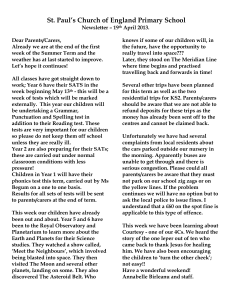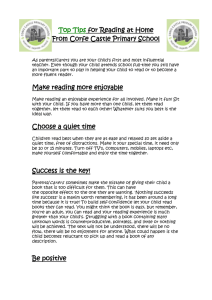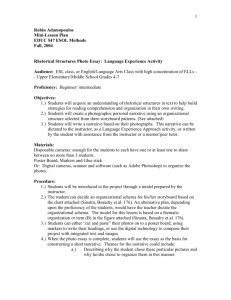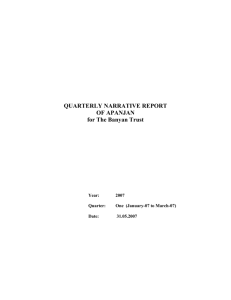Creative Life Story Programme
advertisement
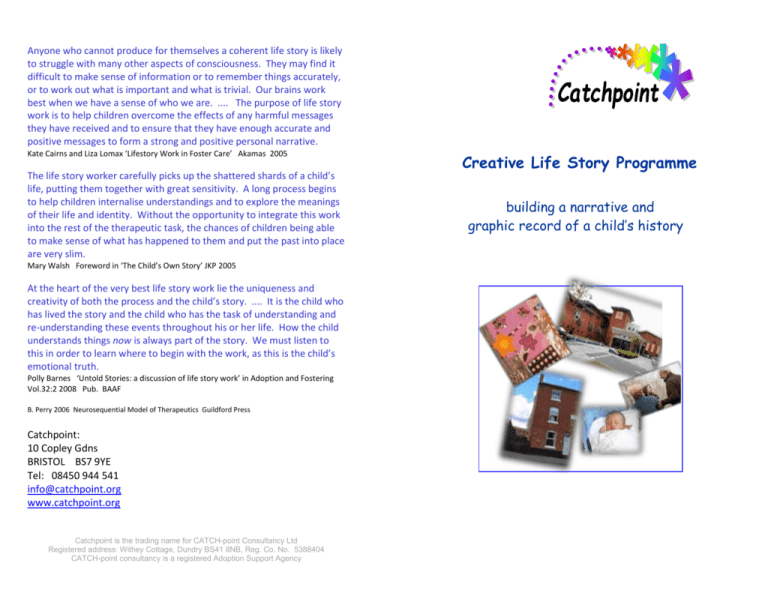
Anyone who cannot produce for themselves a coherent life story is likely to struggle with many other aspects of consciousness. They may find it difficult to make sense of information or to remember things accurately, or to work out what is important and what is trivial. Our brains work best when we have a sense of who we are. .... The purpose of life story work is to help children overcome the effects of any harmful messages they have received and to ensure that they have enough accurate and positive messages to form a strong and positive personal narrative. Kate Cairns and Liza Lomax ‘Lifestory Work in Foster Care’ Akamas 2005 The life story worker carefully picks up the shattered shards of a child’s life, putting them together with great sensitivity. A long process begins to help children internalise understandings and to explore the meanings of their life and identity. Without the opportunity to integrate this work into the rest of the therapeutic task, the chances of children being able to make sense of what has happened to them and put the past into place are very slim. Mary Walsh Foreword in ‘The Child’s Own Story’ JKP 2005 At the heart of the very best life story work lie the uniqueness and creativity of both the process and the child’s story. .... It is the child who has lived the story and the child who has the task of understanding and re-understanding these events throughout his or her life. How the child understands things now is always part of the story. We must listen to this in order to learn where to begin with the work, as this is the child’s emotional truth. Polly Barnes ‘Untold Stories: a discussion of life story work’ in Adoption and Fostering Vol.32:2 2008 Pub. BAAF B. Perry 2006 Neurosequential Model of Therapeutics Guildford Press Catchpoint: 10 Copley Gdns BRISTOL BS7 9YE Tel: 08450 944 541 info@catchpoint.org www.catchpoint.org Catchpoint is the trading name for CATCH-point Consultancy Ltd Registered address: Withey Cottage, Dundry BS41 8NB, Reg. Co. No. 5388404 CATCH-point consultancy is a registered Adoption Support Agency Creative Life Story Programme building a narrative and graphic record of a child’s history The Creative Life Story Programme follows a format of six interactive sessions with a specific sequence. Parents and carers are included in all sessions and are actively encouraged to join in. The sessions are based around art activities, which create an atmosphere of fun and provide a safe way for children to express themselves in media of their choice. Although the sessions are not specifically therapy sessions, they are led by a therapist, which means that emotional responses or difficult reactions can be contained and managed safely. The aims of the Programme are: To construct a concrete sequential narrative of the child’s history to the present day To help children increase their understanding of moves, decisions and experiences in their past To provide opportunity to share experiences and feelings with parents and carers To make real a sense of belonging to both birth and adoptive families. Children make attachments primarily to people but also to places and things. Their sense of time and sequencing can become very muddled, and their sense of self and their internal working model from which they view all relationships and environments becomes distorted as a result of developmental trauma. Activities that are relational, repetitive, relevant and rewarding can help recovery from trauma by increasing regulation of stress response systems in the brain. (B. Perry 2006) The Creative Life Story Programme is based on activities that fulfil these criteria. There may be a need to continue support after the programme with therapy sessions and consultations for the parents to prevent destabilisation or a sense of abandonment. It is therefore important that this programme is not seen in isolation from other Catchpoint programmes. No information is given to children without first being considered with the carers or parents. Siblings of different ages are encouraged to work age appropriately together. Any information that is deemed unsafe or unreliable is not used but kept on file. The sessions take place in the family home unless requested otherwise. A final report is written and sent to all involved parties. There are eight sessions – six of which are direct work with the children. Session 1 Consultation with parents and support worker Session 2 Fantasy House Session 3 Places Session 4 People Session 5 Life Lines Session 6 Family Tree Session 7 Memory Box and card writing Session 8. Review of programme Fantasy House This initial session with the children focuses on introductions and creating a safe environment for the following work. The facilitator gains an insight in to the children’s inner world and their view of themselves in relation to home and family. It is also possible to gage the children’s imaginative abilities and possible areas of conflict or difficulty Places This session focuses on the significant places for the child. This introduces sequence and the idea of progression in a safe way and begins to introduce more direct material from their past. The facilitator will have gathered ground and aerial photos and maps of the significant places in their lives starting with place of birth and finishing with their current home. People This session focuses on the people who have been significant in their lives including birth relatives, foster and respite carers, social workers, school staff, and friends. The people are represented with photos or drawings, and stories and memories are shared. Life Lines This session puts the people and significant events in the child’s life into a diagram that gives a sense of time and sequence. This will include photos and pictures of remembered events such as hospital visits or holidays Family Tree In this session the family tree is made to provide a sense of connection between birth family and adoptive family. It embraces the idea of the whole and extended family. With copies of photos to cut out, the tree is created with roots branches and leaves representing family groups of people in the child’s life (including people who may have died). Memory Box and Cards In this session, memories of things in the children’s life are collected e.g. toys, bedding, furniture or books, and cards are written to people of their choosing that will not be sent. All are stored in a ‘memory box which can be decorated. This is an opportunity for the children to express their feelings at the end of the work about how they feel now, and to record this without raising anxieties of disloyalty. The work from all the sessions is stored in a decorated tube and memory box for each child, which can be kept and shared as they wish.




